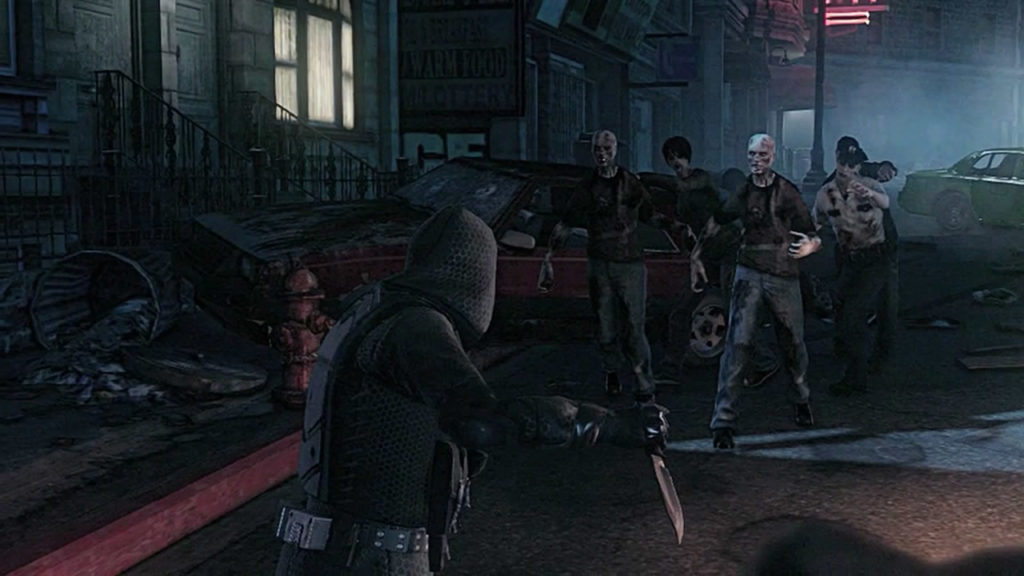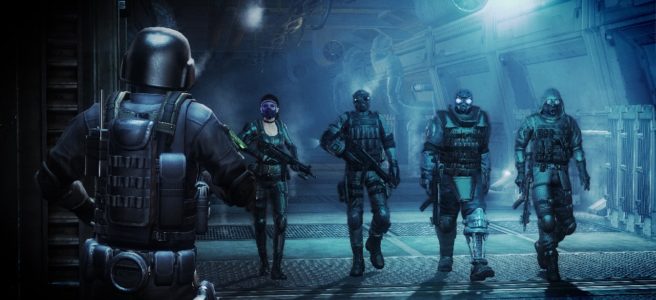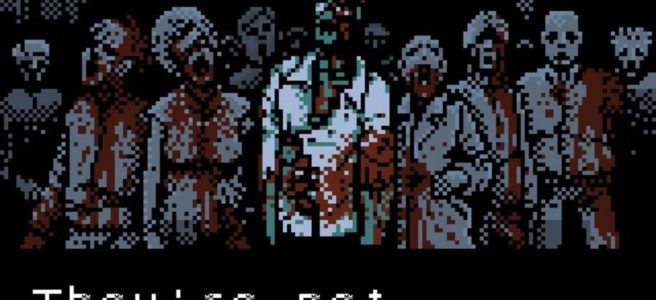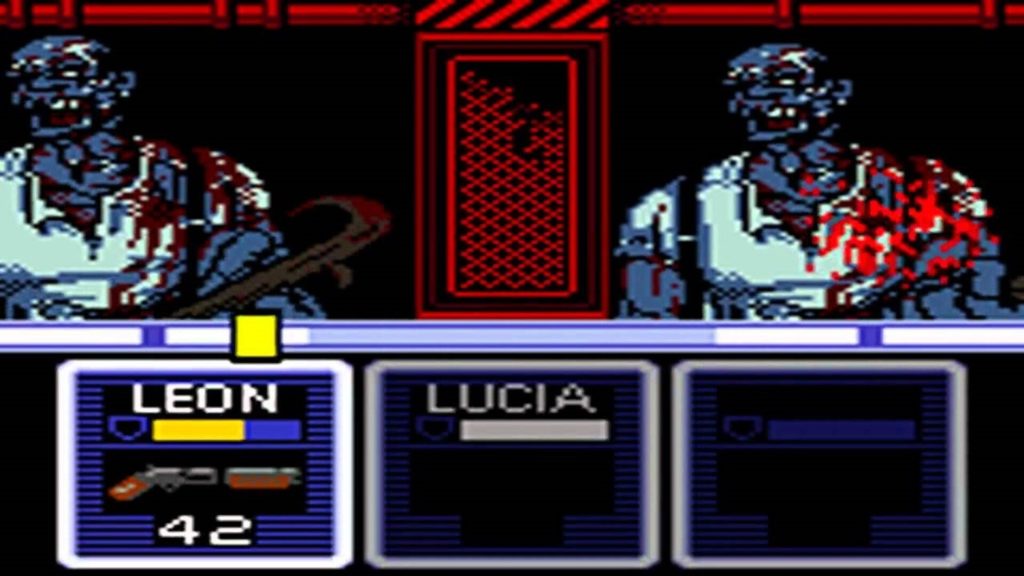Welcome back to the Resident Evil love/hate series! In this entry we’re looking at Resident Evil: Operation Raccoon City, an intriguing spinoff for a number of reasons. For one thing, it was released in the spring of 2012, the same year as Resident Evil 6, and featured squad-based third person shooter gameplay developed by Slant Six Games, who had worked on some latter-day SOCOM U.S. Navy Seals games. Considering the somewhat awkward co-op shooter gameplay the mainline entries were engaging in at the time, the developer’s pedigree suggested that this could have some of the strongest Resident Evil gunplay in the franchise. Perhaps the biggest selling point though was that its story was a non-canon “what if?” scenario where you play as Umbrella special forces going into zombie-overrun Raccoon City to cover up Umbrella’s involvement in the outbreak. The idea of exploring the iconic location on HD consoles was too much for some to pass up, but how did the concept play out in execution? Read on to find out…
Oh, and before we get further, I just want to note that I played this game on the Veteran setting, just in case that difficulty setting added some elements to the game which coloured my perception of it. I wouldn’t be surprised if it did, apparently in this mode enemies receive 25% less damage, inflict 25% greater damage, and drop items with less frequency.

Love
- The Wolfpack – Operation Raccoon City was overtly edgy even when it was released, but playing in 2022 I can’t help but find the way that it leans into “dark, badass evil guys” for its characters endearing. They clearly just looked at HUNK, used him as a baseline and then created a bunch of similarly mysterious, black-clad, mask-wearing special-ops. Their designs are all unified but distinct enough that you can pick them out in the chaos of combat (which, honestly, is pretty impressive considering they’re all dudes in black). They also all have their own special abilities and perks which make playing each member of the team distinct (which, obviously, is important for a squad-based shooter like this). I also enjoy the little touches, like how each character has their own little bio you can read and how cutscenes and dialogue change depending on which characters you’d brought with you on each mission.
- Weapon and Ability Upgrade System – Perhaps unsurprisingly, Operation Raccoon City features a system to upgrade your weapons and abilities using XP you earn in each mission. It’s in the squad lobby screen and isn’t really signposted so you might miss this (I certainly did for the first couple missions), but I was pleasantly surprised to find that each character has dozens of weapons options and multiple perks to choose from, and perks all have multiple ranks you can purchase to increase their effectiveness. It’s nothing revolutionary, but it works and it helps make you feel like you’re growing more powerful as you go.
- It’s Only Like 7 Hours Long – Your mileage is definitely going to vary on this one, but I for one was glad that Operation Raccoon City is a finite, focused experience. You can just play through a shooter story campaign and then be done with it if you want to, or go back to unlock more perks, find secrets, etc.
Mixed
- Snap-to Cover System – As a rule I don’t really like automatic, snap-to cover systems; I prefer to be able to manually enter cover with the press of a button. However, if you’re going to implement a snap-to system then it had better work well. Compared to Resident Evil 5 and 6, Operation Raccoon City‘s implementation is better, although it still has some hiccups that make it more annoying than I’d like. Half the time I’ll get put into cover without wanting to be there, but then when I do want to get into cover it will work seamlessly 99% of the time. However, occasionally you get those stupid situations where you’re in cover and can clearly see an enemy but the game decides you’re not allowed to shoot from the specific spot you’re standing in, so you end up either wiggling until the game decides you can shoot now or just leave cover to get control back, which is always infuriating. Again, I give the cover system some credit for working most of the time, but it has too much in-built annoyance for me to give it any serious praise.
Hate
- Weak, Inaccurate Guns – Operation Raccoon City is a shooter, so you’d hope that they’d make sure that they get the shooting right at the very least, right? Well, unfortunately one of the worst parts about this game is that the guns feel like shooting a fucking peashooter. With your starting assault rifle you can expect to use nearly an entire clip to down a single enemy at medium range. Seriously, as soon as I started the game I noticed that it was taking me around 20 rounds to kill basic enemies; even if you’re a headshot god it takes 2-3 headshots just to down a basic special ops soldier. Playing on Veteran difficulty exacerbated this (enemies get 25% more HP), but requiring 16 rounds on a lower difficulty instead of 20 isn’t a great look either. It also doesn’t help that most of Operation Raccoon City‘s weapons are really ineffective outside of medium range, seemingly gaining massive amounts of random bullet deviation away from where you’re actually aiming and adding substantial damage drop-off. It wasn’t until I unlocked the strongest assault rifle, the Hammer, that it felt like I was doing an appropriate amount of damage. Even this was a double-edged sword though, because the Hammer has a paltry amount of ammo, to the point where I was constantly having to scavenge for ammo boxes to stay alive. That’s the trade-off Operation Raccoon City gives you – lots of ammo but no damage, or good damage but no ammo. Also not helping matters? The guns sounds are also weak, they feel like stock assets and don’t make the shooting feel any better.
- Weird and Unintuitive Controls – Shooters were more-or-less figured out by 2012, which makes it so weird that Slant Six really tried to break the mold with Operation Raccoon City in some truly baffling ways. Why are my active abilities tied to the same button as the melee execution? I don’t know how many times I went to execute an enemy and accidentally activated my temporary invulnerability (thereby putting it on a cooldown when I might need it in the meantime). Why is X the interact button but also the button to perform a slide if you’re moving at the same time? The absolute weirdest decision though is your side-arm. If you tap L2 then it’ll switch to your pistol. That’s weird enough on its own, but if you hold L2 it will let you draw your pistol and the game will auto-target enemies and let you shoot at them for as long as you hold the button down. Naturally, there were lots of moments where I meant to tap or hold L2 and it registered the opposite command, leaving me vulnerable, but the real issue here is how weird the camera controls are when you hold L2. On the one hand, the auto aim is more accurate and reliable than manually aiming. On the other hand, the camera doesn’t follow where you’re aiming at all in this mode, so you’ll be pointing your pistol around and often won’t even be able to see the enemy when you shoot at them. I have no idea what they were thinking when they implemented this control scheme, it’s one of the most baffling core design decisions I’ve ever seen in a AAA game.
- Infuriating, Unfun Enemies – Aside from the zombies (which are actually pretty enjoyable to fight and dismember), every enemy in this game is a chore to fight. Special Ops soldiers? Bullet sponges who always just have a limb or two poking out of cover so you can stagger them out and then shoot them, over and over and over again. NE-α parasites who’ll power up zombies and then detach to infect another one if you don’t shoot them first. Stun-locking lickers who always show up in the dozens. Tyrants who literally take hundreds of rounds to down. Worst of all though are the Hunters who dominate the last couple levels of the game. Fuck. Them. They are bullet sponges who take 3-4 full clips from a Hammer to down, they’ll close the distance to you in an instant, stun-lock you and then rip off massive chunks of HP with each swing, AND they enter the arena in drop pods that trigger when you walk beside their landing zone, meaning that you instantly lose half your HP before the fight has even begun, what the absolute fuck is this bullshit? Seriously, their implementation in this game has got to be one of the most infuriatingly unfun enemies in the entire franchise. Like, I get why the game’s like this – you’ve got to balance it for four people to feel challenged and not just steamroll their way through everything with concentrated fire, but it is really unenjoyable in execution.
- Terrible AI – This entry breaks down into two subsections of note:
- On the bad-but-not-gamebreaking level is that enemies and allies are just plain dumb. You’ll see enemies and allies standing in place all the time, oblivious to the firefight going on around them. You’ll see zombies running in circles, you’ll see zombies right in front of allies and no one is opening fire (in fact, with friendly fire and the random bullet deviation, if you shoot the zombie yourself then you are probably going to do more damage to your allies than the zombie), you’ll see special ops getting swarmed by zombies but decide to shoot you instead… You’ve also got AI so bad at pathfinding that the game will literally teleport NPCs in front of you when needed and hope you don’t notice (I did). It’s pretty much par for the course to expect bad AI in a shooter during this era, but it’s certainly immersion-breaking.
- On the unacceptable end of things though is the sense that this game is out to fuck you over if you dare play the game with AI companions. Seriously, it got so malicious that it began to feel like a cruel joke that the developers were playing on me. We’re talking AI not being able to detect huge, glaringly-obvious trip wire mines and setting them all off, half the map being on fire and the AI just walking into it because they have no pathfinding ability, and an environmental hazard on an elevator where you have to move side to side to avoid flames and of course the AI just stands still the entire time and get barbequed. These hazards would all be so trivial with co-op partners that the devs needn’t bother to include them at all, but with AI partners it feels like an intentionally-cruel, spiteful joke that the devs have included to give you the middle finger for not making three of your friends buy a copy of the game to play with you.
- Noticeably Bad, Poorly-Considered Design – Operation Raccoon City has got to be the most scripted video game I’ve ever played. It feels like such a weird complaint to say, but I can’t think of another game where you could feel the developers’ hands everywhere, where you could feel all the scripted moments triggering when you perform a certain action in a very transparent, ham-fisted fashion. Like, I get that this is how all video games work, but in most games you don’t notice it. In Operation Raccoon City, it’s jarring how obvious it is.
- Most firefights with spec-ops boil down to a handful of enemies rushing into the room and taking cover. The second you kill the last one, three more guys come in from just off-screen and take cover, starting the cycle again. The second the last of this wave dies, the final wave comes in and does the exact same thing. This pattern happens in nearly every spec-ops fight; I was literally calling it before it happened it got so predictable.
- The other really obvious example of this is that like half of the closed doors in the game are zombie jump-scare machines. Walk by a closed door and there’s a good chance that this will trigger the door to open and for a bunch of zombies to suddenly attack you. This will happen whether you’re in the middle of a gun fight (which can be pretty intense), or after you’ve killed everyone and are just exploring the area (in which case it’s just annoying). Humorously, you can also just avoid these doors entirely and they’ll never trigger. Again, this just becomes predictable. It doesn’t really make the combat any more enjoyable, it’s just something that the developers threw in hoping that it would make the game feel tense.
- I also want to mention how the guns and cover system seem to be at odds with each other in this game’s design. As I’ve already said, shooting does less damage and is more inaccurate the further you are from enemies, and the game doesn’t give you enough ammo to win a firefight at range. That suggests that you need to move forward to close in on enemies, but enemies are accurate and points of cover are often far enough away that you’re always going to get shot once when you move forward. Furthermore, health doesn’t regenerate, so you’re almost always going to be low on HP if you play the game the way it incentivizes you. Maybe Slant Six want you to feel like you’re barely hanging on at any given time, but it makes the basic gameplay of Operation Raccoon City frustrating.
- Mindless Gameplay – If Operation Raccoon City had fun shooter gameplay then pretty much all of the other complaints I had here could be ignored, but unfortunately the game gets real dull real fast. The gameplay is truly mindless – unless you’ve completely cleared an area, there’s very little downtime or breathing room; as soon as you reach the next area you’ll be swarmed by zombies or spec-ops all over again. Combat doesn’t have much variety either: zombies make up the majority of the enemy combatants and they just need to be mowed down with impunity, whereas the special ops all follow the same “stagger them out of cover and then pump them full of bullets” gameplay from start to finish. Other than using an active ability to stay alive or conserving some of your ammo because the game is too stingy, there’s barely any thought you have to put into it at all – just shoot, shoot, shoot.
- Ugly Graphics – The PS3/Xbox 360 era were notorious for dreary, dull colour palettes and Operation Raccoon City has to be one of the most soulless games to be released of that generation. It’s so bad that even the blood in this game is so desaturated that it is straight-up black. 10 years on from its release, this game’s graphics are also noticeably aged, with most of the enemy designs looking really bad (William Birkin looks so plasticky, Crimson Heads look like they dyed the standard zombies red, T-108s appear to be made of chrome, a lot of people think that this is the worst-looking version of Nemesis, etc). Considering how many issues this game has, the graphics are the least of its worries, but they’re still bad enough to be worth mentioning.
- Poor Performance – Piggybacking off the last point, Operation Raccoon City‘s performance chugs at times, especially in large, open areas like at city hall or the cemetery. I’m talking like 15FPS for considerable lengths of time, sometimes through entire levels.
- Infection Mechanic is Annoying – Operation Raccoon City has an infection mechanic where if you get attacked by a zombie you can randomly get infected with the T-virus and then have a limited amount of time to dose yourself with the anti-virus or become infected and start attacking your teammates (or just get a game over if you are playing solo). On the fun side of things, your enemies can also become infected and start attacking their allies when they succumb. This did happen once or twice in my playthrough and, honestly, seeing a spec-ops soldier turn and go off on his allies was really cool. However, for the most part it’s just annoying. Anti-viral sprays are the only way to stave off an infection and if you don’t have one on you then your only option is to sprint around to find one (bonus: they also happen to be pretty rare, maybe 2 or 3 per level), hope an ally will save you (bonus: AI companions won’t do jack shit for you) or just die. This means that infection is either little more than a nuisance, or it’s a game over that takes way longer to complete than normal. Even infected enemy soldiers aren’t that common either as you’ll usually just gun them down before they can be turned.
- Several Awful Gameplay Segments – Even with everything I’ve mentioned above, for a while I was thinking “well, at least this game’s only about 7 hours long, I’d probably prefer this game over Resident Evil 6‘s bloated 20 hour campaign…”. However, the further I went, the more infuriating moments cropped up that were literally causing me to reevaluate my distaste for Resident Evil 6, which is always a sign that someone has made a major mistake.
- On the more minor end of things, the first level ends with a QTE boss fight with William Birkin and you barely have any time to react to the prompts, which usually means you’ll die in a hit or two. It was bad enough that I died on this several times, and then you have to try to run away from him while figuring out which direction to go in, dodging obstacles and trying to avoid getting stun-locked. It was a really annoying way to cap off the start of the experience.
- The first real taste of how bad this game gets though is the Power Generator station. Sometimes this game just becomes pure, unfiltered chaos. It’s a pretty simple objective – raise three generators and plant an EMP on each. The complication is that you’ve got spec-ops spawning all around you whenever you interact with a console, zombies appearing from nowhere throughout the entire fight and Nicholai from Resident Evil 3‘s up on a catwalk during the entire fight sniping at you and there are very few safe places you can hide from him. It makes for an incredibly difficult and frustrating battle as you’re rarely able to find a safe place to hide from Nicholai and the spec-ops’ gunfire, let alone find an opening to activate the generators and EMPs. You’re always going to take some damage, meaning that you then have to find health pickups to stay in the fight (oh and for a fun bonus, one of the health pickups in the area is glitched to make it hard to pickup unless you approach from a very specific angle). Oh, and to make matters worse, if you die at any point here, you have to redo the entire fight (eg, it doesn’t checkpoint after each generator is destroyed). I imagine it’s significantly easier with co-op partners, but that doesn’t make it any better designed, it’s just throwing unending waves of shit at you in place of actual difficulty.
- Next is the Nemesis fight, which should be a highlight of the game, but instead is just mindless. Here you pump Nemesis with a seemingly endless number of bullets (which absolutely no feedback from him to show that you’re doing anything), while hordes of zombies swarm into the room and then special ops soldiers show up halfway through to make it even more chaotic (and tank the performance even more). Given how weak this game’s guns are, it should be no surprise that I went through all my ammunition and grenades several times just trying to put a dent in this giant, annoying sponge of an encounter.
- The Umbrella lab level is also so poorly thought out. You’ve got barely any ammo pickups, bullet-spongey Hunters and Crimson Heads are everywhere and barely any health pickups, meaning that you’re just dying over and over again. It got bad enough that I just said fuck it and started running for the exit instead of actually playing the game, which was the only reason I managed to get through to the end of this level at all.
- The crown shit has to go to the final level though. My God was it awful. Once again, no ammo pickups for your weapons, swarms of zombies and Crimson Heads are everywhere which will infect you in seconds before you’ve gotten a chance to find an antiviral spray, snipers picking you off from so far away that your weapons won’t be able to hurt them (and for a bonus I had a sniper glitch to be able to shoot me through the wall of a crate, hooray)… and this is literally just the first area. In the next area you’ve got a literal endless swarm of Crimson Heads spawn in and run at you. If you try to play smart, take cover and whittle them down, then the devs clearly think you’re a fucking idiot because you will be overwhelmed. To make matters worse, I actually managed to have two people join my game at this point (in 2022 no less!) and we were still being overrun, forced into an endless retreat and were each downed several times. If not for being able to be revived I would have undoubtedly died here many times, but after my fifth or sixth death I decided to run and dodge past the zombies until I reached a ladder to end this part of the level. You then have to choose to fight or defend Leon (I chose to fight him, obviously), which results in yet another bullet sponge boss battle as you pump dozens of sniper rifle rounds into the rookie cop, while fighting everyone else who chose to defend him. It is a truly shitty fight and the ending is just embarrassing as Claire gets executed off-screen and the game immediately cuts to credits, no epilogue, fanfare or anything. What a shitshow of a level, literally not a moment of fun to be had in it.
Operation Raccoon City has the spark of a good idea buried in it, but the execution is so fatally flawed that it somehow manages to be even worse than the bloated and much-maligned Resident Evil 6. One kind of wishes that Capcom would have tried to iron out the issues with this game for a sequel but… well, they gave us Umbrella Corps instead.


